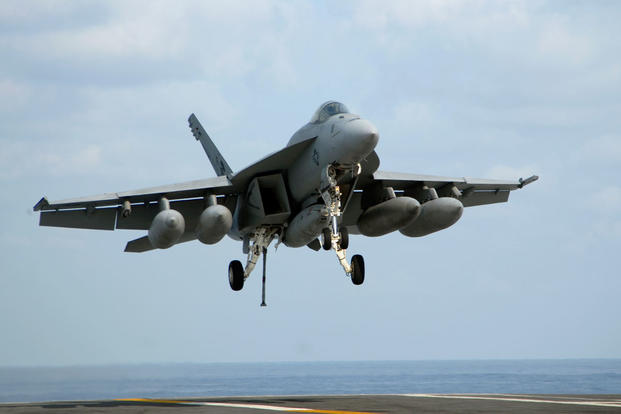Naval Air Forces Commander Vice Adm. Mike Shoemaker is still at a loss to explain how the Navy suffered three Class A mishaps and three lost aircraft in an eight-day period in May and June of this year.
But, he added, it's just as hard to explain how the fleet went the previous eight months with just one mishap.
As the Navy seeks to claw back readiness amid aging aircraft and the residual effects of sequestration budget cuts, some look to draw a connection between the rash of recent mishaps and readiness shortfalls. Shoemaker said the data just doesn't support this conclusion.
"As I look back at those [mishaps] and then the last couple of years, trying to make a tie to readiness and proficiency, in every case it's not there," he said.
On May 26, two F/A-18F Super Hornets crashed following a collision off the coast of North Carolina. All four crew members ejected safely. And on June 2, an F/A-18C Hornet that was part of the Navy's prestigious Blue Angels demonstration team crashed during air show practice near Smyrna, Tennessee, killing the pilot, Blue Angels soloist and Marine Capt. Jeff Kuss.
In an incident that drew less attention but was still identified as "Class A," meaning $2 million or more in damage was done, an EA-18G Growler suffered in in-flight arresting gear engagement leading to nose landing gear and engine damage May 29 during operations in the South China Sea.
But overall, Shoemaker said, major Navy aircraft mishaps are on a downward trajectory.
"Look at the trends … from '14 to '15 to where we are today, actually the trends for Navy aviation are coming down," Shoemaker said. "I wouldn't characterize it as a crisis; I can't make that connection."
Shoemaker, who spoke to an audience at the Center for Strategic and International Studies in Washington, D.C. Thursday, said he expected to brief Chief of Naval Operations Adm. John Richardson and Marine Corps Commandant Gen. Robert Neller on the Navy's ongoing readiness recovery plan. He emphasized the launch of a service-life extension plan for the Navy's F/A-18 E/F Super Hornets, the first of which entered service in 1999 and will reach its 6,000-hour service life threshold sometime next year.
"We've got to make sure we get that right," Shoemaker said. "I think if we look at where we are,we can't afford to have 50 percent of the fleet out of reporting. We've got to keep that down; one-fifth, maybe, is our target."
He acknowledged that the Navy's strike fighter squadrons, which fly Hornets and Super Hornets were among those most acutely affected by required maintenance that leaves fewer aircraft available for missions and can cut into the flight hours that pilots need to stay ready and proficient. The others are the Navy's C-2 Greyhound and E-2 Hawkeye aircraft, which support aircraft carriers.
On average, he said, aircraft flight hours remain above the "tactical hard deck" or minimum safe number determined by the Navy. And, he said, aircraft readiness is improving, albeit gradually.
"The needles are moving and they're movinng slowly, not as fast as [Davis] or I would like," he said. 'But I think we have the problem bounded and I think we've got the support we need in most cases."
--Hope Hodge Seck can be reached at hope.seck@military.com. Follow her on Twitter at @HopeSeck.





























